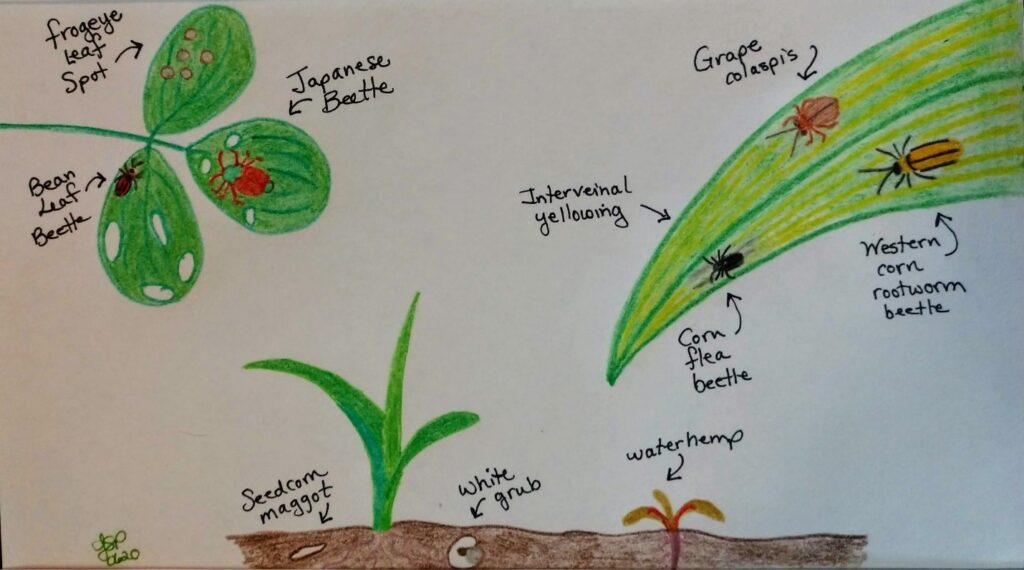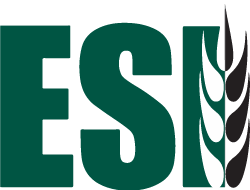Why we don’t always treat when we see a problem
When I scout a field, I look for anything out of the ordinary during the growing season. Each part of the season brings a new set of challenges. Early on, there are weeds to consider, emergence problems, and seedling diseases. Later in the season, I look for nutrient deficiencies, insect feeding, and root and foliar diseases. I look for damage from wind and drought.
When I do see something that is out of the ordinary, I don’t always recommend acting on it. I’m not just looking at insects for the opportunity to spray insecticides, and I’m not going to tell the producer to find a fungicide whenever I see a disease.
Why is that?

There are several reasons.
First, there isn’t always something we can do about the problem. For example, if there’s a water shortage or a drought in a dryland or rainfed field, I can note the leaves curling and plants wilting, but there’s no pivot to turn on. All we can do is hope for rain. In another case, there’s a new pest haunting soybeans in my area called the soybean gall midge. We don’t have much knowledge about the little fly-like creature, but the adults spend their time in the ditches and woods surrounding the fields and only come into the fields to lay their eggs. Once they hatch, the larvae, which are barely visible to the naked eye, quickly find cracks in the stems to hide away, burrowing into the interior of the plant. Neither the adults nor the larvae would be affected by an insecticide treatment in the field—the adults aren’t in the field for very long, and the larvae are too well protected by their burrowing habits. So alternate and preventative treatment considerations are being discussed. For now, we observe and report.
Second, it isn’t always the right time of the year to treat the problem. I recently saw some corn plants with yellow whorls and interveinal chlorosis. This definitely could be the sulfur we had yet to apply to the field, but more likely it was due to a pH problem. When the plants are in the field, it isn’t the right time to be applying lime to correct the pH. So, again, we can apply the sulfur, but have to schedule the lime for after harvest in the fall or next spring before planting. Alternately, the problem could be larvae that had eaten their way through much of the vegetation, but most of them were already in pupae—they won’t be eating anything as adults, so it doesn’t warrant treating pupae who won’t respond to the insecticide. Also, just because you see evidence of feeding on plants, doesn’t mean you see the critter that has been feeding on them—you may be treating a critter that isn’t even there anymore.
Third, the problem isn’t always at the economic threshold to be able to warrant treating the problem. No field is going to be perfectly pest-free, and no plant is going to be perfectly free of some sort of feeding or disease. Universities come out with what they call “economic thresholds”, or the point at which a pest is going to create enough harm to the plant that yield will be adversely affected, and the extra expense of treating the field is worth it. Not only are you paying for the chemical, but there’s the application fee if someone else does the application, and equipment cost, fuel, and time spent driving in the field if you do the application yourself. The potential income from yield lost has to outweigh the cost to treat the pest. In the case of insects, it may be number of insects per plant or amount of total feeding on the plant (percent of defoliation), in which every leaf on the plant is considered for total loss. In the case of diseases, it may be percent of the field affected by the disease or number of lesions on each plant.
Sometimes, scouting a field is more of an art form than a cut and dry numbers game. Just because you see the critter out there—or even the evidence of it, doesn’t automatically mean there is something that can or should be done about it. But that also doesn’t mean you shouldn’t be out there watching things grow, and keeping an eye on things. Because the moment that threshold is crossed, and the season is right, timing is of the essence. It helps to have someone that knows what they are looking for, and knows what they are looking at.
It helps to have someone outstanding in the field. [Yup. I had to throw that pun in there.]
Who’s looking out for your crops?
Thanks for reading.
